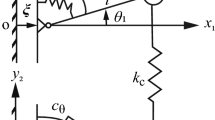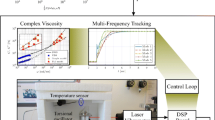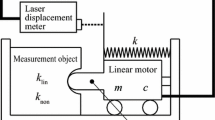Abstract
In this study, a method of measuring the added mass for an object oscillating in a viscous fluid using nonlinear self-excited oscillations was developed. The added mass produces an additional inertial effect on the vibrating object. In previous methods, the added mass is obtained experimentally from the response frequency and amplitude at the peak in the frequency response curve under a harmonically forced excitation. However, such methods cannot be utilized in highly viscous environments because the peak becomes ambiguous as a result of damping. Moreover, in very high-viscosity environments, the resonance peak ceases to exist in the frequency response curves. To solve this problem, self-excited oscillations were induced in the system using linear velocity feedback. Because linear velocity feedback can be used to eliminate the viscous damping effect when the linear feedback gain is set near the Hopf bifurcation point related to self-excited oscillations, the object becomes self-excited at a frequency equal to the natural frequency of the object oscillating in a vacuum, i.e., the undamped natural frequency. What distinguishes the proposed method from the abovementioned previous methods is that the value of the response is not needed; however, a reduction in the oscillation amplitude is required to obtain accurate measurement results. In the proposed method, to avoid an increase in the response amplitude under the applied linear velocity feedback, nonlinear feedback is also applied to produce a limit cycle similar to that produced in a van der Pol oscillator. A prototype of the measurement system was constructed based on the proposed method. A comparison of the experimentally and theoretically obtained added mass values confirmed the validity of the proposed method for added mass sensing.





Similar content being viewed by others
References
Chen, S.S., Wambsganss, M.W., Jendrzejczyk, J.A.: Added mass and damping of a vibrating rod in confined viscous fluids. J. Appl. Mech. 43(2), 325–329 (1976)
Chen, S.S.: Flow-Induced Vibration of Circular Structures. Hemisphere, Washington (1987)
Blevins, R.D.: Flow-Induced Vibration, 2nd edn. Van Nostrand Reinhold, New York (1990)
Paidoussis, M.P.: Fluid-Structure Interactions, 2nd edn. Elsevier, Oxford (2014)
Amabili, M., Pasqualini, A., Dalpiaz, G.: Natural frequencies and modes of free-edge circular plates vibrating in vacuum or in contact with liquid. J. Sound Vib. 188, 685–699 (1995)
Amabili, M., Kwak, M.K.: Free vibration of circular plates coupled with liquids: revising the Lamb problem. J. Fluids Struct. 10, 743–761 (1996)
Kwak, M.K., Amabili, M.: Hydroelastic vibration of free-edge annular plates. J. Vib. Acoust. 121(1), 26–32 (1999)
Yeolho, L., Geunbae, L., Wonkyu, M.: Piezoelectric micro-cantilever bio-sensor using the mass-micro-balancing technique with self-excitation. Microsyst. Technol. 13, 563–567 (2007)
Murray, R.E., Thresher, R., Jonkman, J.: Added-mass effects on a horizontal-axis tidal turbine using FAST v8. Renew. Energy 126, 987–1002 (2018)
Karimpour, M., Ghaderi, R., Raeiszadeh, F.: Vibration response of piezoelectric microcantilever as ultrasmall mass sensor in liquid environment. Micron 101, 213–220 (2017)
Campbell, G.A., Mutharasan, R.: Sensing of liquid level at micron resolution using self-excited millimeter-sized PZT-cantilever. Sens. Actuators A Phys. 122(2), 326–334 (2005)
Ma, S., Huang, H.: The virtually added mass effect of air on a pre-stressed micro-diaphragm sensor. Vacuum 166, 57–63 (2019)
Uchiyama, T.: Numerical prediction of added mass and damping for a cylinder oscillating in confined incompressible gas-liquid two-phase mixture. Nucl. Eng. Des. 222(1), 68–78 (2003)
Adhikari, S.: Inertial mass sensing with low \(Q\)-factor vibrating microcantilevers. J. Appl. Phys. 222(1), 144304 (2017)
Kurita, Y., Matsumura, Y., Tanaka, A., Tomon, T.: Self-excited driving and active vibration control on vibratory machine by velocity feedback control with variable gain. Trans. Jpn. Soc. Mech. Eng. Ser. C 68(678), 2859–2864 (2002)
Ramos, D., Mertens, J., Calleja, M., Tamayo, J.: Phototermal self-excitation of nanomechanical resonators in liquids. Appl. Phys. Lett. 92(17), 173108 (2008)
Yabuno, H., Kaneko, H., Kuroda, M., Kobayashi, T.: Van der Pol type self-excited micro-cantilever probe of atomic force microscopy. Nonlinear Dyn. 54(1–2), 137–149 (2008)
Tanaka, Y., Yabuno, H.: Measurement of softening cubic nonlinear and negative linear stiffness using van der Pol type self-excited oscillation. Nonlinear Dyn. 83(1–2), 283–290 (2016)
Yabuno, H., Higashino, K., Kuroda, M., Yamamoto, Y.: Self-excited vibrational viscometer for high-viscosity sensing. J. Appl Phys. 116(12), 124305 (2014)
Nayfeh, A.H., Mook, D.T.: Nonlinear Oscillations. Wiley, New York (2008)
Acknowledgements
The present study was supported in part by a Grant-in-Aid for Scientific Research B (Grant No.19H0209B) from the Japan Society for the Promotion of Science (JSPS).
Author information
Authors and Affiliations
Corresponding author
Ethics declarations
Conflict of interest
The authors declare that they have no conflict of interest.
Additional information
Publisher's Note
Springer Nature remains neutral with regard to jurisdictional claims in published maps and institutional affiliations.
Appendices
Appendix A
In this appendix, the closed solution of the added mass for a circular plate oscillating in a viscous fluid is derived. Fig. 6 shows a schematic of the plate according to Fig. 1. The motion of the viscous fluid is shown in this figure. When the Reynolds number of the fluid is very small, the Navier–Stokes equation can be simplified as
The velocity of the fluid along the y-axis is governed by Eq. (34), where the \(\mu \) and \(\rho \) are the viscosity and density of the fluid, respectively. The case of a sinusoidal displacement of the plate was considered here. The displacement in this case is given by
where i is the imaginary unit and a and \(\omega \) are the complex amplitude and frequency, respectively. The velocity and acceleration of the plate are then, respectively, expressed as
It was assumed that interfaces between the fluid and the plate and wall are no-slip interfaces. Hence, the fluid velocity is zero at the wall and equal to the excitation velocity at the plate. Thus, the boundary conditions of the velocity of the fluid at \(y=0\) and \(y=h\) are expressed as
where h is the distance from the wall of the container to the plate. With the above boundary conditions, u(y, t) is expressed as
where \(\gamma =\sqrt{\frac{\omega \rho }{2\mu }}\). From Newton’s law of viscous flow, the fluid force along the x-axis is
where \(\alpha (b)\) and \(\beta (b)\) are expressed as
The first term on the right-hand side of Eq. (39) expresses the inertial force, which is what causes the added mass phenomenon. Thus, the theoretical value of the added mass is derived as
Appendix B
We measured the vibration in the y-direction at a point near the center of the plate (diameter: 76 mm) which is self-excited at a frequency of 12.9 Hz in the x-direction (Fig. 4). The experimentally obtained time histories in the x- and y-directions are plotted in Fig. 7a and b, respectively. Figure 8a and b presents the associated FFT analysis. The main frequency component corresponds to the natural frequency of the system given by Eq. (4), i.e., a rigid plate subjected to forces from a spring and fluid, but not to the natural frequencies associated with the elastic deformation of the plate. The amplitude of the oscillation in the y-direction was much smaller than the diameter of the plate (76 mm) and the amplitude of the oscillation as a rigid body in the x-direction. This characteristic probably holds for the other plates (diameters: 80 mm and 100 mm) used in the experiments described in this paper. Therefore, because the plates can be regarded as rigid bodies in the x-direction without elastic deformation in y-direction, these plates are suitable to confirm experimentally the validity of the proposed method, which is to measure the added mass for rigid plates oscillating in viscous fluids.
Rights and permissions
About this article
Cite this article
Yang, J., Yabuno, H., Yanagisawa, N. et al. Measurement of added mass for an object oscillating in viscous fluids using nonlinear self-excited oscillations. Nonlinear Dyn 102, 1987–1996 (2020). https://doi.org/10.1007/s11071-020-06087-3
Received:
Accepted:
Published:
Issue Date:
DOI: https://doi.org/10.1007/s11071-020-06087-3







